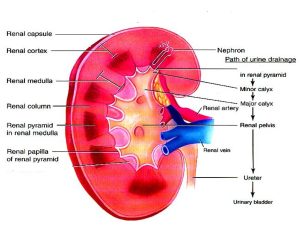Anatomy and functions of KIDNEYS and MCQs for NEET, GPAT, SSC, GATE, RRB Pharmacist,
ANATOMY OF KIDNEY

The kidneys lie on the posterior abdominal wall , one on each side of the vertebral column. They extend from T12 to L3 vertebrae and in this way they get protection from lower ribs. The right kidney is slightly lower than the left one because of the space occupied by the liver.
These are bean-shaped organ of about 11cm long, 6cm wide and 3cm thick. It weighs around 150g. they are held in the position by the mass of fats. The renal fascia is a sheet of fibrous connective tissue that surrounds the kidney and the renal fat.
Both the kidneys are associated with different organs like-
The right kidney:- superiorly is the right adrenal gland, anteriorly is the right lobe of the liver and posteriorly is the diaphragm and abdominal wall muscles.
The left kidney:- superiorly is the left adrenal gland, anteriorly is the spleen, stomach, pancreas etc and posteriorly is the diaphragm, posterior abdominal wall muscles.
The kidney is divided in 3 sections-
• Outer fibrous capsule that surrounds the kidney.
• The cortex is the reddish-brown tissue which is present just below the capsule and outside the renal pyramids
• The medulla is the innermost layer which consist of pale conical shaped structure known as renal pyramids.
The hilum is a medial border where the blood vessels, lymph vessels, ureters and nerves enter.
The urine formed in the kidney pass through the renal papilla at the apex(base) of the renal pyramids into the minor calyx. Large no. of minor calyx merge to form the major calyx. The 2-3 major calyx combines to form the renal pelvis which is funnel shaped structure and leaves the kidney as the ureter. Peristalsis, intrinsic contraction of smooth muscle facilitates the flow of urine through the renal pelvis, ureters to the bladder.
The kidney contains 1-2 millions of nephrons which are the functional units of kidneys and some of the collecting duct which allows the urine to flow from the pyramids to the calyxes.
NEPHRONS
The nephron is like tubule which is closed at one end and joins to the collecting duct at the other end. The closed end of nephron is a cup shaped structure known as glomerular capsule which completely surrounds the network of tiny capillaries known as glomerulus. Continuing the glomerular capsule is the remaining nephron which is about 3 cm long and is divided in 3 parts
• The proximal convoluted tubule(PCT)
• Loop of Henle
• The distal convoluted capsule(DCT)
After entering the kidney through the hilum, the artery divides to form the tiny arterioles. In the cortex, an arteriole called the afferent arteriole reaches all the glomerular capsule and they again subdivides in tiny capillaries forming the glomerulus where the filtration of urine takes place . the blood vessels leading ahead from the glomerulus is the efferent arteriole. The afferent arteriole has larger diameter than efferent arteriole because of which the pressure inside the glomerulus increases and filtration occurs. The efferent arteriole again divides in a capillary network, which surrounds the remaining of the tubule which allows exchange of fluid between the tubule and the blood stream. The venous drain from the capillary bed leaves the kidney as renal vein.
The glomerular capsule and the glomerulus is made up of flattened epithelial cells while the remaining part of nephron and the collecting duct are made of simple squamous epithelium.
Functions of kidneys include-
1. Formation of urine
2. Excretion of waste products
3. Production and secretion of erythropoietin, the hormone that stimulates the production of RBCs
4. Production and secretion of rennin.
Multiple choice questions(MCQs)
1. where are the kidneys situated?
A. posterior wall of abdominal cavity B. pelvic cavity
C. Below the pelvic cavity D. above the pelvic cavity
2. what is the approximate length and thickness of kidneys?
A. 10cm and 5cm B. 11cm and 3cm
C. 5cm and 3cm D. 15cm and 5cm
3. what is the structure that encloses the kidneys?
A. hilum B. renal papilla
C. renal fascia D. renal pyramid
4. Which of the following organ is associated anteriorly with the right kidney?
A. stomach B. pancreas
C. jejunum D. none of the above
5. Which of the following statement is NOT true?
A. the medulla is the pale conical shaped structure
B. the diaphragm is associated posteriorly with both the kidneys
C. renal pelvis is a cup shaped structure
D. the loops of henle is also known as medullary loop.
6. Which structure allows the entry of blood vessels, lymph vessels and nerves to enter kidneys?
A. cortex B. fibrous capsule
C. hilum D. major calyx
7. Match the following-
a)cortex 1. Surrounds the kidney
b) medulla 2. Contains renal pyramids
c)capsule 3. Outside the renal pyramid
d)major calyx 4. Formed from the merging of minor calyxes.
8. what is the function of kidney?
A. secretion of erythropoietin B. excretion of waste
C. formation of urine D. all of the above
9. The renal pelvis leaves the kidney as?
a. ureters B. urethra
C. urinary bladder D. renal fascia
10. what is the approximate weight of the kidneys?
A. 100g B. 200g
C. 500g D. 1000g
ANSWERS:-
1. posterior wall of abdominal cavity
2. 11cm and 3cm
3. renal fascia
4. none of the above
5. renal pelvis is a cup shaped structure
6. hilum
7. a) – 3 b) – 2 c) – 1 d) – 4
8. all of the above
9. ureters
10. 500g
Participate in Online FREE GPAT TEST: CLICK HERE
Participate in Online FREE Pharmacist TEST: CLICK HERE
Participate in Online FREE Drug Inspector TEST: CLICK HERE
REFRENCE: 1. Ross and Wilson-Anatomy and physiology in health and illness; 12th edition; page no.-: .